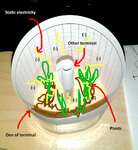c_mitra
Advanced Member level 6
"do not exceed maximum arc distance, energy can not be released due to high pressure, it can damage module"..
This is the most common mode of failure. Most likely there is a relaxation oscillator and a transformer. If you keep the secondary wires so far that no arc can take place, it will appear to the transformer that there is no load. Because there are no internal mechanism for regulation, the voltage will increase and internal sparking may take place. Some of these voltages may be reflected back and cause serious and irreversible damage to the single transistor - and this will be hard to repair.
